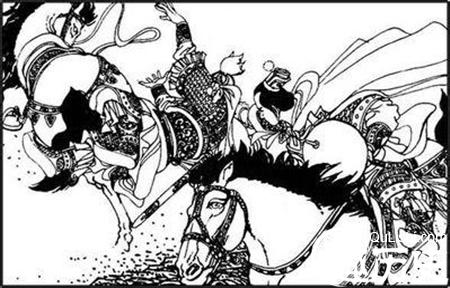When it comes to flies, mosquitoes, fleas and rats, no one knows or tires, so in the poetry of the past, there are very few works on the theme of these four small animals. Among the Ming songs, there are not only songs with flies, mosquitoes, fleas and rats as the theme, but also literati writers to write, and the artistic value and ideological value are very high, which is really refreshing!
Intriguingly, what is the point of composing lyrics for flies, mosquitoes, fleas and rats?
Ming Qu has a song called "Wing Fly"
【Double tone Falling Plum Wind】Wing Fly

Network illustration
From Jiaoxia,
Until autumn,
Entangled in the left and right.
Forgive you with your mouth,
Can you taste the smell?
This song satirizes the fly flying around from early summer to late autumn, and even if it is full of mouths, it is impossible to distinguish the incense and smell. The author is the famous Ming Sanqu writer Jin Luan. In the song "Wing Fly", Jin Luan is nominally written about the annoying fly, but in fact, he is satirizing the social atmosphere of inflamation and the unscrupulous people who are sneaking around and patting horses. During the reign of Emperor Xizong of the Ming Dynasty, there was a great eunuch named Wei Zhongxian, who controlled the government and was nepotistic, "from the six ministries of the cabinet to the governor of the four sides, he put the party to death." That is to say, from the central ministries and commissions of the state to the local military and political leaders, there are Wei Zhongxian's dead parties, and these dead parties are really "entangled in the left and right" of Wei Zhongxian. They were particularly creative in their tendency to inflame and follow the trend, and the most prominent manifestation was the establishment of a "living shrine" for Wei Zhongxian. What is a "shrine"? Ancestral halls, or ancestral halls, were originally ancestral temples where people sacrificed dead ancestors or sages; Ancestral halls built for the living are called "ancestral halls". For thousands of years in Chinese history, there have been many heroes, loyal subjects, great writers, and great scientists, but it is very rare that they can be used to praise and remember the "ancestral shrine" set up by the people. However, this group of flies wanted to set up a "living shrine" for Wei Zhongxian.
The first "fly" was Inspector Pan Ruzhen of Zhejiang. On the second day of the sixth leap month of the sixth year of the Apocalypse, he proposed to the emperor to establish a shrine for Wei Zhongxian. He wrote: "Wei Zhongxian of the East Factory, who was diligent in his heart and the country, who read and cared for the people, who was injured by the disaster in the two zhejiang years, who laid the foundation for all the expenses of the tea and fruits, and who cited the evils accumulated along the bad habits of a hundred years, not only did the machine households turn over and reinvent themselves, but all the people who belonged to the soil were singing and dancing in the streets, and they were happy to tell each other, and the public asked to build a shrine and use the blessings." The Wei Zhongxian disaster relief and relief mentioned in the Song Shu is pure nonsense, and there is no such thing at all; It is also said that the common people sang and danced in the streets and alleys to thank Wei Zhongxian for their kindness, which was also made up. Look at the imperial court's reply to Pan Ruzhen: "According to the music, Wei Zhongxian was diligent in serving the country and cherished the people... It is advisable to follow the invitation of the crowd, use the Jiansheng Ancestral Hall, and build it in the place to immortalize. "If a person is still alive, he must be "immortal", which is the only one in Chinese history, and there is no other store. In fact, this reply was made by Wei Zhongxian, who was in a position of great power, himself.
The imperial court approved Pan Ruzhen's request, and at once countless "flies" were busy building a shrine for Wei Zhongxian. For example, Ying Tian patrolled Mao Yilu and built a shrine at Tiger Hill in Suzhou; Yan Mingtai, the governor of Jiliao, built a shrine in Jizhou, Miyun, Changping, Tongzhou, Zhuozhou, Hejian and Baoding; Zhang Pu, the governor of Xuanda, built a shrine in Xuanfu and Datong; Inspector Cao Erzhen of Shanxi built a shrine on Mount Wutai... These are all foreign ports, and the big "flies" in the capital are even more busy, the Ministry of Works Langzhong Zeng Guozhen built a shrine by the Lugou Bridge, the five cities yushi Huang Xianqing built a shrine outside xuanwu gate, and Yin Li Chunmao of Shuntianfu built a shrine inside Xuanwu Gate... There was only one Xuanwu Gate, and there was Wei Zhongxian's ancestral hall inside and outside the door.
There was also the boldest "fly", who actually repaired Wei Zhongxian's ancestral hall next to the royal mausoleum. For example, Xiaoling Wei commanded Li Zhicai to build a shrine in front of the Ming Tombs; Xue Maoxiang, the governor of Hedao, was the most creative, and he built Wei Zhongxian's ancestral hall next to the mausoleum of Zhu Yuanzhang, the founding emperor of the Ming Dynasty in Fengyang, Anhui.